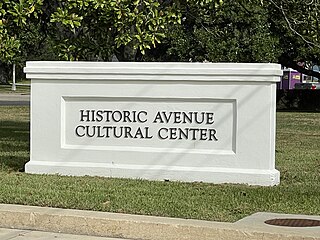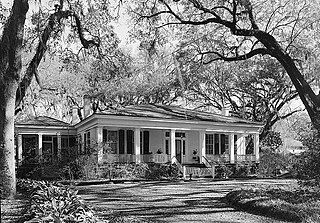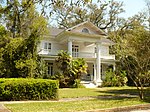
Ashland Park is a historic early 20th century neighborhood in Lexington, Kentucky, United States. It was named after Ashland, the estate of Kentucky statesman Henry Clay which is located in the eastern portion of the neighborhood. The 600-acre (2.4 km2) development was designed by the famous landscape architecture firm the Olmsted Brothers of Massachusetts. The neighborhood belongs to the National Register of Historic Places.

Augusta Jane Evans Wilson, was an American author of Southern literature and a supporter of the Confederacy during the American Civil War. Her books were banned by the American Library Association in 1881. She was the first woman to earn US$100,000 through her writing.

The architecturally and historically significant Historic Avenue Cultural Center is an exhibit and event space that serves as an anchor to Mobile, Alabama’s budding Civil Rights and Cultural Heritage District. From the early 1990s to approximately 2015, it served as the National African American Archives and Museum. Formerly known as the Davis Avenue Branch of Mobile Public Library, it was the lone Black library in Mobile County during segregation.
The Church Street East Historic District is a historic district in the city of Mobile, Alabama, United States. It was placed on the National Register of Historic Places on 16 December 1971. Since a boundary increase on 13 January 1984, it is roughly bounded by Broad, Conti, Water, Claiborne, and Canal Streets. 20 April 2005 saw the further addition of 66 & 68 Royal Street to the district. The district covers 1,403 acres (5.68 km2) and contains 83 contributing buildings and one object. It contains portions of Mobile's 19th century downtown area and features government, museum, commercial, and residential structures in a variety of 19th-century styles. The buildings range in age from the 1820s to 1900 and include the Federal, Greek Revival, Renaissance Revival, Italianate, and various other Victorian architectural styles. Notable buildings include the Government Street Presbyterian Church, Barton Academy, and the Ketchum House.
The Old Dauphin Way Historic District is a historic district in the city of Mobile, Alabama, United States. It was named for Dauphin Way, now known as Dauphin Street, which bisects the center of the district from east to west. The district is roughly bounded by Broad Street on the east, Springhill Avenue on the north, Government Street on the south, and Houston Avenue on the west. Covering 766 acres (3.10 km2) and containing 1466 contributing buildings, Old Dauphin Way is the largest historic district in Mobile.

The Oakleigh Garden Historic District is a historic district in Mobile, Alabama, United States. It was placed on the National Register of Historic Places on 13 April 1972. It is centered on Washington Square and was originally bounded by Government, Marine, Texas, and Ann Streets. A boundary increase on 30 January 1991 increased the boundaries to Rapier Avenue, Selma, Broad, and Texas Streets. The district covers 1,453 acres (5.88 km2) and contains 288 contributing buildings. The buildings range in age from the 1820s to the 1940s with most in a variety of 19th-century architectural styles.

The Campground Historic District, also known as The Campground is a historic district in the city of Mobile, Alabama, United States. Named for the Old Camp Ground, a military encampment that occupied the property during the American Civil War, this historically African-American neighborhood was placed on the National Register of Historic Places on July 7, 2005. It is roughly bounded by Martin Luther King Jr. Avenue, Rylands Street, St. Stephens Road, and Ann Street. The district covers 370 acres (1.5 km2) and contains 166 contributing buildings. The houses range from shotgun houses to bungalows and date from the late 19th century to the middle 20th century.
The Midtown Historic District is a historic district in the city of Mobile, Alabama, United States. It was placed on the National Register of Historic Places on November 29, 2001, with a small boundary increase on November 18, 2020 It is roughly bounded by Taylor Avenue, Government Street, Houston Street, Kenneth Street, Springhill Avenue, and Florida Street. The district covers 467 acres (1.89 km2) and contains 1,270 contributing buildings. The majority of the contributing buildings range in age from the 1880s to the 1950s and cover a wide variety of architectural styles. The district was significantly affected by a tornado on December 25, 2012.

Highland Heights–Stevens' Subdivision Historic District is a residential historic district located in Highland Park, Michigan along five east-west streets: Farrand Park, McLean Street, Colorado Street, Rhode Island Street, and Massachusetts Street, between Woodward Avenue on the west and Oakland Avenue on the east. The district was listed on the National Register of Historic Places in 1988.

The Catlin Wilson House, also known as the Murphy Dunlap House, is a historic Greek Revival style house in Eutaw, Alabama, United States. The one-story wood-framed building was built in 1844. A pedimented front portico with four Doric columns covers the three central bays of the front facade. The house was recorded by the Historic American Buildings Survey in 1936. It was listed on the Alabama Register of Landmarks and Heritage on November 5, 1976. It was subsequently added to the National Register of Historic Places as a part of the Antebellum Homes in Eutaw Thematic Resource on April 2, 1982, due to its architectural significance.

The Woodlawn Historic District is a nationally recognized historic district located in Iowa City, Iowa, United States. It was listed on the National Register of Historic Places in 1979. At the time of its nomination it consisted of 14 resources, all of which are contributing buildings. The district is largely on Woodlawn Street, a gravel dead-end extension of Iowa Avenue. The eastern terminus of Iowa Avenue was originally planned to be a block to the west and was to be the location of the Governor's Mansion, but it was never built. The Old Capitol is on western terminus of the same street. The district is an enclave of upper-middle-class houses on Woodlawn and Evans Streets. Nine of the houses were built in the late 19th century, two were built in the 1920s, and two were built in mid-20th century. There is also a four-story Tudor Revival apartment building on Evans Street that was built in 1926. All of the buildings are located on deep set-backs on large landscaped lots that provide seclusion and cohesion, which is what gives them their significance. The most prominent house is a Queen Anne style home at 1036 Woodlawn Street.
Old Shell Road is a thoroughfare located in Mobile, a city in Mobile County, Alabama, United States.

This is a list of the National Register of Historic Places listings in Mobile, Alabama.

The D'Iberville Apartments is a complex of historic apartment buildings located in Mobile, Alabama. They were built in 1943 to the designs of architects Harry Pembleton and Aurelius Augustus Evans. They were constructed in a Minimal Traditionalist style of architecture and are notable for their significance to the community planning and development of Mobile during World War II, a time of tremendous growth in the city. The apartments were added to the National Register of Historic Places on September 3, 2004.

Georgia Cottage, also known as the Augusta Evans Wilson House, is a historic residence in Mobile, Alabama, United States. It was added to the National Register of Historic Places on September 14, 1972, based on its association with Augusta Jane Evans. She was one of the most popular American novelists of the nineteenth century and the first female author in the United States to earn over $100,000 for her work, but has been largely forgotten in recent times.

George Bigelow Rogers (1870–1945) was an American architect, best known for the wide variety of buildings that he designed in Mobile, Alabama, including mansions in historic European styles and other private residences, churches and public buildings, and the first 11-story skyscraper in Mobile and the Southeast United States. Many of his structures have been listed on the National Register of Historic Places.
The Spanish Revival Residences in Mobile Multiple Property Submission is a multiple property submission of buildings that were listed together on the National Register of Historic Places as some of the best remaining examples in Mobile, Alabama of houses built in the Spanish Colonial Revival style. It covers ten properties.
The Maysville Historic District is a historic district in Mobile, Alabama, United States. The district covers 451 acres (183 ha) and contains 1121 properties located southwest of downtown and directly south of the Leinkauf Historic District. Platted in 1871 in the midst of a recession in Mobile, the neighborhood did not begin to develop until the late 1890s. Maysville has long been a working class neighborhood; many late 1890s and early 1900s houses were bungalows and cottages, some with modest Victorian influences. Some larger and more decorated houses were built in the northeastern portion of the neighborhood. In the early 20th century and into World War I and World War II, the Port of Mobile and its shipyards became a focus of Mobile's economy, and the population grew in response. The early 20th century saw many craftsman-style bungalows and four square houses built. Minimalist Traditional and some ranch-style houses became popular around and after World War II. Notable contributing buildings in the district are Ladd–Peebles Stadium, built in 1948, and Williamson High School, built in 1965. The district was listed on the National Register of Historic Places in 2013.

The Wood Avenue Historic District is a historic district in Florence, Alabama. The residential neighborhood was primarily developed after Reconstruction, although five houses date from before the Civil War. By the time of Florence's economic boom of the 1880s, the most fashionable upper-class neighborhood in Florence, today known as the Sannoner Historic District, had already been filled in, leading development to move to Wood Avenue to the west. Most homes built during this time were large, Victorian structures, including many elaborate examples of Queen Anne architecture.

The West Second Street Historic District is located along a primary commercial street in Ashland, Wisconsin, and is listed on the National Register of Historic Places. West Second Street was later renamed Main Street West.























